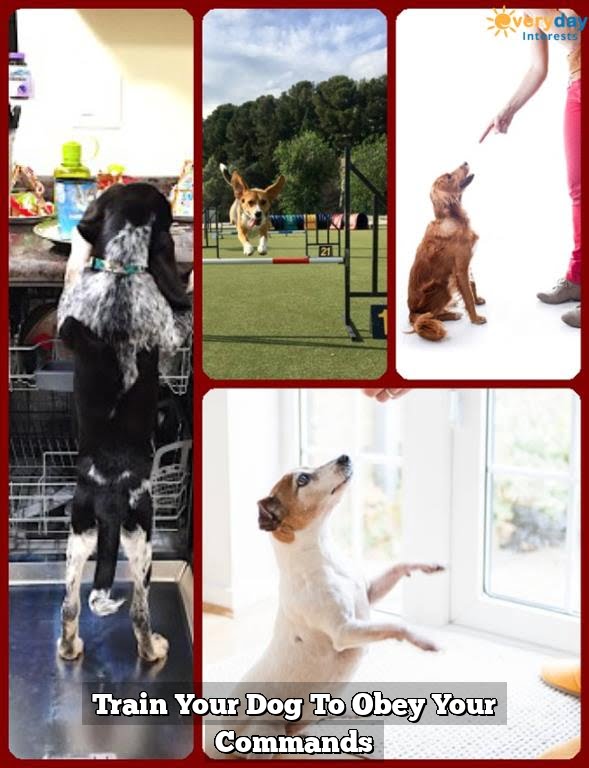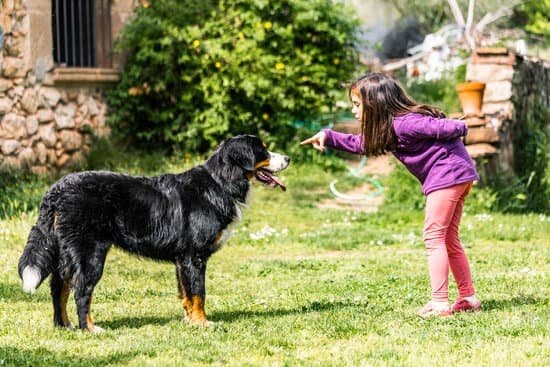Training commands for a new dog is an essential aspect of ensuring their well-being and fostering a harmonious relationship between pet and owner. Teaching your dog the right commands can provide them with structure, discipline, and promote good behavior. In this article, we will explore the importance of command training for a new dog, how it sets the foundation for further obedience, and the steps involved in preparing for effective training.
When bringing home a new dog, whether it’s a puppy or an adult rescue, establishing clear communication through training commands is crucial. Not only does it create boundaries and rules for your furry friend to follow, but it also promotes their mental stimulation and sense of accomplishment. Training commands allow you to guide your dog’s behavior positively and effectively, providing them with structure and confidence.
Before delving into specific command training techniques, it is essential to understand why good command training is imperative for every dog. Dogs are pack animals by nature and prefer order and consistency. By teaching them commands such as sit, stay, or lie down, you establish yourself as the leader while ensuring their safety in various situations.
Additionally, obedience training helps eliminate unwanted behaviors like jumping on guests or pulling on the leash during walks. It’s not just about controlling your dog; it’s about nurturing their emotional well-being through consistent communication.
To ensure successful command training sessions with your new dog, it is crucial to create a positive and consistent environment that motivates learning. This involves setting up a designated area dedicated to training sessions where distractions are minimized.
Equally important is utilizing reward-based techniques that reinforce desired behaviors rather than using punishment or forceful methods that may harm the bond between you and your pup. Consistency in expectations from all household members helps prevent confusion for your new furry family member.
In the following sections of this article, we will dive deeper into understanding the basics of command training for dogs-covering topics such as choosing the right commands tailored to meet your dog’s needs, step-by-step guides for teaching essential commands like sit and stay, as well as advanced commands to enhance obedience and control.
We will also explore effective techniques for reward-based training, how to address common training mistakes, and setting realistic expectations along the training journey.
By establishing a strong foundation of command training with your new dog, you are not only shaping their behavior but also building a lifelong bond based on trust and understanding. So let us embark on this journey of training your new dog together and witness the transformation that proper command training can bring to their lives.
Understanding the Basics
Every dog owner knows that training their new furry friend is an important part of ensuring a happy and harmonious relationship. But why exactly is good command training essential for every dog? Understanding the basics of command training can help owners realize the many benefits it brings to both their four-legged companion and themselves.
Firstly, good command training establishes clear communication between the dog and its owner. Dogs are not born understanding human language, so teaching them commands allows us to effectively convey our expectations and desires. This leads to improved obedience and reduces frustration for both parties involved.
When a dog understands and follows commands, it enhances their overall safety as well. They learn to respond appropriately in different situations, such as staying put when approaching a busy road or coming back when called in a park.
Furthermore, command training plays a crucial role in behavior management. By teaching dogs basic commands like “sit” or “stay,” owners are able to establish boundaries and set rules. This helps prevent unwanted behaviors such as jumping on people or pulling on the leash during walks. When dogs know what is expected of them, they become more relaxed and less likely to engage in destructive or disruptive behavior.
A well-trained dog is also more likely to have positive interactions with others, including humans and other animals. Owners who invest time in command training will find that their furry companions are easier to take out in public spaces, interact kindly with guests at home, and get along better with other dogs at the park. This not only improves socialization skills but also encourages responsible pet ownership within communities.
In summary, good command training is absolutely essential for every dog due to its various benefits for both the canine and its owner. It fosters clear communication, enhances safety, manages behavior effectively, promotes positive interactions with others, and ultimately strengthens the bond between dog and owner.
Preparing for Training
When it comes to training your new dog, creating a positive and consistent environment is crucial. This section will provide you with some valuable tips on how to prepare yourself and your home for effective command training.
Establish Clear Rules and Boundaries
Before you begin training your dog, it’s important to establish clear rules and boundaries in your home. Dogs thrive when they have structure and routine, so make sure everyone in the household is on the same page.
Decide where your dog will be allowed to go, what furniture they can or cannot sit on, and any other house rules that are important to you. Consistency is key here – if you allow your dog on the couch one day but not the next, they will become confused and may not respond well to training.
Create a Safe and Distraction-Free Training Area
When it’s time for a training session, it’s best to find a quiet area in your home where there are minimal distractions. This could be a specific room or even just a designated corner of a room where you can set up some space for training exercises.
Remove any objects or items that might distract your dog during the session, such as toys or food bowls. It’s also helpful to close doors or use baby gates to prevent your dog from wandering off during training.
Gather Essential Training Supplies
Before you start training, gather all the necessary supplies to ensure smooth and efficient sessions. You’ll need treats that are both delicious and small enough for quick consumption, as these will serve as rewards when your dog obeys commands successfully.
Additionally, having a clicker or a verbal marker (such as saying “yes” or “good”) can be useful in signaling to your dog that they’ve done something correctly. Lastly, make sure to have a leash and collar or harness that fits properly, as these will be handy for teaching commands such as “heel” or “come”.
By following these tips, you can create an environment that sets your dog up for success in their training journey. Remember, a positive and consistent atmosphere will not only make training easier but will also contribute to a stronger bond between you and your canine companion.
Choosing the Right Commands for Your Dog
Understanding Your Dog’s Breed and Personality
When it comes to training a new dog, one size does not fit all. Every dog is unique, with different breeds and personalities requiring different approaches to training. It is essential to understand your dog’s breed characteristics and individual temperament in order to choose the right commands for effective training.
Take the time to research your dog’s breed and understand their natural instincts, strengths, and weaknesses. For example, if you have a herding breed like a Border Collie, they may have a strong instinctual drive to chase and herd.
In this case, commands that focus on impulse control and obedience will be important for their training. On the other hand, if you have a retriever breed like a Labrador Retriever, commands like “fetch” or “drop it” may come more naturally due to their innate desire to retrieve objects.
Additionally, consider your dog’s personality traits such as their energy level, sociability, and confidence. Some dogs may be more independent and stubborn while others may be eager to please and highly motivated by treats or praise. These factors will influence the type of commands that are most suitable for your dog’s training.
Keeping Commands Clear and Consistent
Once you have an understanding of your dog’s specific needs and preferences, it is crucial to choose commands that are clear and consistent. Dogs thrive on routine and repetition, so using consistent verbal cues or hand signals will help them understand what is expected of them.
When selecting specific commands for your dog, avoid using similar sounding words or phrases to prevent confusion. For example, if you choose the command “sit,” make sure it doesn’t sound too similar to another command like “stay.” Consistency also means using the same tone of voice every time you give a command so that your dog can easily recognize the cue.
- It can be helpful to use short one – to two-syllable words for commands as they are easier for dogs to understand and remember. Be mindful of the words you choose, ensuring they are distinct from everyday vocabulary to avoid unintentional associations or confusion.
Customizing Commands Based on Your Goals
In addition to considering your dog’s breed and personality, it is important to customize commands based on your training goals. Whether you plan on doing agility competitions, therapy work, or simply want a well-behaved family pet, tailoring your dog’s training commands will help them develop the skills and behaviors needed for their specific role.
For example, if you aspire to compete in obedience trials, focusing on commands like “heel,” “front,” and “finish” will be essential. If you want a dog who can assist with household chores, commands like “fetch,” “take it,” and “drop it” are crucial.
- Remember that the training process is not set in stone – as your dog progresses and gains new skills, you can evolve their training by introducing more advanced or specialized commands. Stay flexible and be willing to adapt your training methods to best suit your dog’s individual needs and capabilities.
Teaching the Basics
Teaching your new dog essential commands is a crucial part of their training journey. These basic commands, such as sit, stay, and lie down, provide the foundation for good behavior and help establish your role as the leader. In this section, we will provide you with a step-by-step guide to effectively train your dog on these essential commands.
- Sit: Teaching your dog to sit is often one of the first commands you should focus on. Start by holding a treat close to your dog’s nose, then move it upwards and slightly back towards their tail. As their head follows the treat, their bottom should naturally lower into a sitting position. Once they sit down, praise them and give them the treat as a reward.
- Stay: The stay command is important for keeping your dog in one place until you release them. Begin by having your dog sit or lie down. Open your palm towards them and say “stay,” taking a step backward away from them without turning around. If they remain in position, go back to them, reward them with praise and treats, and gradually increase the distance and duration of staying.
- Lie Down: To teach your dog to lie down on command, start by having them sit in front of you. Hold a treat close to their nose and lower it straight down towards the ground between their paws while saying “lie down.” As their head follows the treat, they should naturally lower themselves into a lying position. Once they are lying down, praise them and give them the treat as a reward.
Mastering these essential commands will create a strong foundation for further training with your new dog. Remember to always use positive reinforcement techniques such as treats and praise when teaching these commands to ensure a positive learning experience for your furry friend.
| Command | Training Method |
|---|---|
| Sit | Hold a treat close to the dog’s nose and move it upwards and slightly back, rewarding them when they sit down. |
| Stay | Have the dog sit or lie down, open your palm towards them and say “stay,” gradually increasing the distance and duration. |
| Lie Down | Hold a treat close to the dog’s nose and lower it straight down towards the ground between their paws while saying “lie down,” rewarding them when they lie down. |
Building on the Basics
Building on the Basics: Advanced Commands to Enhance Obedience and Control (Come, Leave it, Drop it)
Once your dog has mastered the basic commands of sitting, staying, and lying down, it is time to move on to advanced commands that will further enhance their obedience and control. These commands are essential for keeping your dog safe and well-behaved in various situations. In this section, we will explore the importance of teaching your dog commands such as “come,” “leave it,” and “drop it,” along with step-by-step instructions on how to train them.
Come Command
The come command, also known as recall, is crucial for ensuring your dog’s safety and controlling them in potentially dangerous situations. Teaching your dog to come when called can be a lifesaver if they ever wander off or approach something they shouldn’t. To start training this command, begin in a distraction-free environment with a high-value treat in hand.
Call your dog’s name followed by the word “come” in an enthusiastic tone while moving backward. When your dog reaches you, reward them with praise and the treat. Gradually increase distractions as your dog becomes more proficient at responding to the command.
Leave It Command
The leave it command is vital for preventing your dog from picking up hazardous substances or grabbing items they shouldn’t have in their mouth. Start by showing your dog a treat in one closed hand and say “leave it” firmly. Wait for them to stop trying to get the treat from your hand before rewarding them with a different treat from the other hand.
Practice this exercise with various objects and gradually increase difficulty by dropping treats on the floor or using more tempting items. With consistent practice, your dog will learn to ignore unwanted things when commanded to leave it.
Drop It Command
The drop it command is useful when your dog has picked up something they should not have in their mouth. It helps prevent situations where your dog might swallow a dangerous object or become possessive. Begin by holding a toy or low-value item in your hand that your dog enjoys playing with. Let them hold the object and then present another toy or treat, saying “drop it” as you do so.
Gently try to take the object from their mouth, avoiding any tug-of-war games. As soon as they release the item, reward them with praise and the second toy or treat. Consistency is key in reinforcing this command.
By teaching these advanced commands, you will enhance your dog’s obedience and control level, making them safer and more reliable in a variety of situations. Remember to be patient and consistent as training may take time and different dogs learn at different paces. In the next section, we will explore effective techniques for reward-based training using positive reinforcement to further motivate and encourage your dog’s learning process.
The Power of Positive Reinforcement
Positive reinforcement is one of the most effective techniques for training a new dog and is based on the principle of rewarding desired behaviors. By using positive reinforcement, you are encouraging your dog to repeat actions that you want them to learn. This method focuses on rewarding your dog with praise, treats, or playtime when they exhibit desired behaviors. It helps to build a positive association with the command and encourages your dog to obey willingly.
One of the key components of positive reinforcement training is timing. You need to provide the reward immediately after your dog has performed the desired behavior. This ensures that they associate the reward with the correct action and reinforces their understanding and motivation to follow your commands in the future.
Another important aspect of positive reinforcement training is consistency. Consistently rewarding your dog for good behavior helps them understand what is expected of them and reinforces those behaviors over time. It’s essential to use the same command word or gesture consistently so that your dog can make direct connections between their actions and your expectations.
Using rewards that are highly motivating for your dog also enhances the effectiveness of positive reinforcement training. Different dogs have different preferences, so it’s important to find out what rewards work best for your furry friend. Some popular rewards include small treats, verbal praise, toys, or even extra playtime with their favorite activities.
In summary, positive reinforcement is a powerful tool for teaching commands to a new dog. Its effectiveness lies in providing immediate rewards and being consistent in reinforcing desired behaviors. By using this technique, you can create a positive learning environment for your dog and enhance their willingness to follow commands obediently.
| Benefits of Positive Reinforcement |
|---|
| 1. Builds a strong bond between you and your dog. |
| 2. Increases motivation and eagerness to learn. |
| 3. Creates a positive association with training. |
| 4. Fosters obedience and responsiveness to commands. |
Patience and Persistence
Training a new dog can often come with its fair share of challenges. It is important to remember that each dog learns at their own pace and may require different approaches when it comes to training. In this section, we will discuss the importance of patience and persistence when dealing with these challenges, as well as how to correct common training mistakes.
- Be Patient: When it comes to training a new dog, patience is key. Dogs may not understand commands immediately and it can take time for them to grasp what is expected of them. It is important to remain calm and patient during the training process, as frustration or impatience can hinder progress.
- Practice Consistently: Consistency is crucial in training a new dog. Set aside regular training sessions each day to reinforce commands and work on new ones. Dogs thrive on routine and repetition, so consistent practice will help them understand what is expected of them more quickly.
- Reinforce Good Behavior: One common mistake in dog training is focusing solely on correcting bad behavior instead of reinforcing good behavior. Make sure to praise and reward your dog when they perform a command correctly, whether through treats, verbal praise, or affection. This positive reinforcement helps your dog associate obedience with rewards and encourages them to continue behaving appropriately.
- Addressing Mistakes: Correcting mistakes during training is necessary but should be done gently and without punishment. If your dog makes a mistake while learning a command, calmly redirect them back to the correct behavior without scolding or yelling. Use positive reinforcement to guide your dog in the right direction.
- Seek Professional Help if Needed: If you find yourself struggling with certain aspects of training or if you feel like you have hit a roadblock, don’t hesitate to seek professional help from a certified dog trainer or behaviorist. They have the expertise and experience to address specific challenges and provide tailored guidance for you and your pet.
By being patient and persistent in training your new dog, you can overcome challenges and correct common training mistakes. Remember to practice consistency, reinforce good behavior, and address mistakes with positivity and redirection. Through these methods, you can help your dog learn commands effectively and develop a strong foundation for obedience and discipline.
Setting Realistic Expectations
When training a new dog, it is important to have realistic expectations of their progress. Just like humans, dogs have different learning abilities and it may take time for them to fully grasp the commands being taught. It is essential for dog owners to recognize and celebrate their dog’s progress along the way.
One effective way to set realistic expectations is to understand that dogs learn at different paces. Some dogs may pick up commands quickly while others may require more time and repetition. It is important not to compare your dog’s progress with that of other dogs as each dog has their own unique learning style.
To recognize your dog’s progress, keep track of their achievements using a training journal or checklist. This will allow you to see how far they have come since the beginning of their training journey. Celebrate each small success with rewards, praise, and positive reinforcement. This will not only motivate your dog but also strengthen the bond between you.
Here are some ways you can celebrate your dog’s progress:
- Verbal praise: Give your dog enthusiastic verbal praises such as “Good job.” or “Well done.” when they successfully perform a command.
- Treats: Reward your dog with their favorite treats when they demonstrate improvement or mastery of a command.
- Playtime: Set aside special playtime where you engage in fun activities with your dog as a reward for their efforts in training.
- Toys: Introduce new toys as rewards for completing difficult commands or achieving specific milestones in training.
By setting realistic expectations and celebrating your dog’s progress, you create a positive learning environment that encourages them to continue learning and improving. Remember, training should be an enjoyable experience for both you and your furry friend, so make sure to have patience, persistence, and celebrate every step forward along the way.
Beyond Commands
Many dog owners focus solely on teaching their new dog commands, without realizing the importance of bonding and nurturing their emotional well-being. Beyond obedience, a strong bond and emotional connection with your dog are essential for a happy and well-adjusted pet. This section will explore the significance of bonding with your dog and provide tips for nurturing their emotional well-being.
One of the most effective ways to build a strong bond with your dog is through quality time and positive interactions. Spending dedicated one-on-one time with your dog helps them feel loved, valued, and secure in their relationship with you. Some activities that promote bonding include daily walks, playtime, grooming sessions, or simply snuggling on the couch.
Additionally, it’s important to provide mental stimulation for your dog to keep their mind engaged and prevent boredom. Engaging in interactive games like puzzle toys or training sessions not only helps strengthen the bond but also provides an outlet for their energy and natural instincts. Incorporating these activities into your routine not only nurtures your dog’s emotional well-being but also deepens the connection between you.
Lastly, remember that dogs are social creatures who thrive on companionship. Make sure to include opportunities for socialization with other dogs or humans to prevent any feelings of isolation or loneliness. Enrolling in training classes or setting up playdates can be great ways to expose your dog to new experiences while building their confidence and enhancing their emotional well-being.
Conclusion
In conclusion, training commands for a new dog is not just about obedience, but it also plays a crucial role in establishing a strong and healthy bond between you and your furry companion. By understanding the basics of command training and creating a positive environment for your dog, you are laying the foundation for a successful training journey.
Choosing the right commands that suit your dog’s needs is essential as every dog has different abilities and learning styles. By starting with the basics such as sit, stay, and lie down, you are teaching your dog fundamental commands that will enhance their obedience and control. As you progress to advanced commands like come, leave it, and drop it, you are further reinforcing their training and fostering better communication.
The power of positive reinforcement cannot be overstated when it comes to training your new dog. Reward-based techniques not only motivate your dog but also strengthen the bond between you both. However, it’s important to note that training takes time, patience, and persistence. It’s normal to encounter challenges along the way but by staying consistent and correcting common mistakes, you will overcome them.
Ultimately, embrace this lifelong training journey with your new dog as an opportunity to nurture their emotional well-being. Beyond just commands, focus on building a strong bond through quality time spent together. Remember to set realistic expectations based on their progress while celebrating their achievements along the way. With dedication and love, you will create a well-trained dog who trusts and respects you wholeheartedly.
Frequently Asked Questions
What are the first commands to teach a new dog?
When teaching a new dog, it is essential to start with basic commands that are foundational and easy to grasp. The first commands to teach a new dog usually include “Sit,” “Stay,” and “Come.”
These commands are fundamental for building trust, establishing boundaries, and ensuring safety for both the dog and their owner. By starting with these basic commands, owners can lay a solid foundation for further training and create a clear line of communication with their furry companions.
How long does it take to train a dog a new command?
The time it takes to train a dog a new command can vary depending on several factors such as the individual dog’s temperament, breed, age, prior training experiences, and the consistency of training methods used. Generally, it takes patience and repetition to successfully train a dog. For simple commands like “Sit” or “Stay,” an average dog may take several weeks of consistent practice before they fully understand and respond reliably to the command.
However, more complex or specialized commands may require longer periods of training and reinforcement. It is important for owners to remember that each dog learns at their own pace, so consistency, positive reinforcement, and patience are key when teaching new commands.
What are the 7 most important dog commands?
While there are many important commands for dogs to learn based on individual needs and circumstances, seven commands often considered crucial in any training program are: “Sit,” “Stay,” “Down,” “Come,” “Leave it/Drop it,” “Heel/Loose leash walking,” and “Off.” Each command serves its own purpose in ensuring obedience, control over impulsive behavior, safety during outings or interactions with other animals or people, as well as overall good manners. For instance, sit teaches the dog impulse control while staying teaches them self-restraint until given permission to move again.
Other commands like come and off provide invaluable recall skills which promote the dog’s safety while preventing accidents or conflicts in various situations. Mastering these seven important commands enhances not only the communication and bond between dogs and their owners but also enables a well-behaved and happy canine companion.

Welcome to the blog! I am a professional dog trainer and have been working with dogs for many years. In this blog, I will be discussing various topics related to dog training, including tips, tricks, and advice. I hope you find this information helpful and informative. Thanks for reading!





